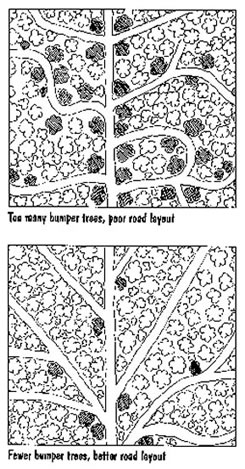Recommended Voluntary Forest Management Practices for New Hampshire
5.4 LOGGING DAMAGE
BACKGROUND
Excessive damage to residual trees during a timber harvest can negate the intended benefits of forest improvement operations.
Activities associated with felling, winching, and skidding can damage 20 to 40 percent of the residual trees (trees left behind).
Young trees may be bent or broken during felling or crushed by harvesting equipment. Branches and tops of residual trees may be broken during felling, reducing crown area and eventually tree vigor. Valuable lower trunks of larger trees may be wounded, allowing entry of fungi or insects that cause wood discoloration and decay. Injuries resulting in exposed sapwood wounds of 100 square inches or greater are likely to develop decay. Approximately 80 percent of skidding injuries are from bark scraped from the butt log of residual trees.
Skidding can cause root damage, allowing entry of rot-causing microorganisms. Repeated passes of heavy equipment over certain types of soils, especially during wet conditions, can compact soil air spaces, impeding root growth. Most healthy forest soils maintain about 50 percent solids, 25 percent air space and 25 percent water by volume. When these ratios change through compaction, roots are damaged and their growth restricted, erosion and run-off increase due to decreased permeability, and changes in soil temperature and microbial action disrupt soil nutrient cycling.
Logging may also combine with other stress factors to make individual trees (and eventually entire stands) more susceptible to dieback. Poor vigor invites attacks by insect pests and diseases. Also, though a stand may not be physically damaged, removing trees may reduce the stand's ability to withstand wind.
OBJECTIVE
Control and minimize logging damage to residual trees, and reduce the total area of soil compacted during harvest operations.
CONSIDERATIONS
- Research indicates experienced operators can limit damage to the residual stand to 10 percent or less.
- Minimizing damage depends equally on supervision, skid trail locations, and care in felling and skidding.
- More damage occurs when bark is loose during spring and early summer; take extra caution if you can't avoid harvesting during these times.
- Certain species (e.g. paper birch and balsam fir) are more susceptible to damage than others.
- Trees growing on very dry, wet, or windy sites, as well as those that have a history of insect or disease attacks are less likely to survive logging damage.
- Elements contributing to compaction include site conditions such as soil texture (particle size), soil moisture, unevenness of the ground, and slope. The number of passes and equipment characteristics also contribute. These include total weight of the equipment, vibration, speed, pressure on the soil (pounds per square inch or psi), tire- or track-tread design, and operator experience. Logger training, experience, attitude, and motivation are more important than equipment size in minimizing logging damage.
- Wet soils and fine-textured soils compact more readily than dry and or coarse soils.
- Soil compaction affects the type, productivity, and timing of natural regeneration.
- Forest floor scarification is often desired to promote regeneration.
RECOMMENDED PRACTICES
- Plan and mark skid trails and landings to accommodate the equipment, as well as skidding needs of future harvests. Reuse existing trails. For partial harvests keep the area dedicated to skid trails at or below 20 percent of the total harvest area.
- Use loggers skilled in proper directional felling, winching, and skidding procedures. Ask for references.
- Include contract provisions that provide incentives to minimize damage, and impose sanctions in the event of careless damage to the residual stand.
- Use equipment appropriate for the size and density of the trees, soil, and site conditions.
- Use branches (slash) in skid trails as a protective road bed.
- Use "bumper" trees along skid trails to protect residual trees.
- Harvest trees on sensitive or wet soils when the ground is during frozen or dry.
- Use group or patch cutting to reduce damage to the residual stand. Under this method trees can be felled toward newly created openings, rather than toward the residual stand.
- Work around pockets of advanced regeneration. Harvesting when a heavy snow cover is present will help protect small seedlings and saplings.
- Avoid harvesting heavily defoliated stands for two or three growing seasons to minimize stress on the trees.
- Avoid exposing adjacent uncut stands to prevailing winds.
- Monitor the harvest to make sure the operation is being properly conducted.
CROSS REFERENCES
2.3 Regeneration Methods; 3.1 Timber Harvesting Systems; 3.2 Logging Aesthetics; 3.3 Aesthetics of Skid Trails, Truck Roads and Landings; 3.5 Soil Productivity; 5.1 Insects, Diseases.
ADDITIONAL INFORMATION
Bennett, K. P. (tech. coordinator). 2001. Proceedings of Residual Stand Damage Workshop. UNH Cooperative Extension. http://extension.unh.edu/resources/files/Resource000410_Rep432.pdf Accessed March 11, 2010.